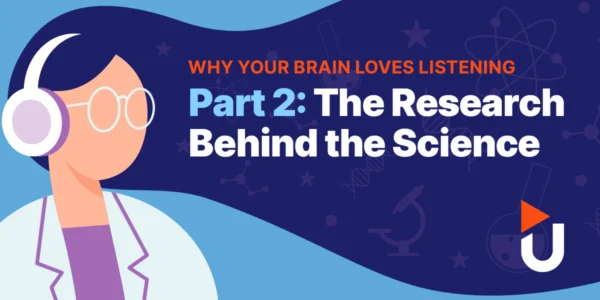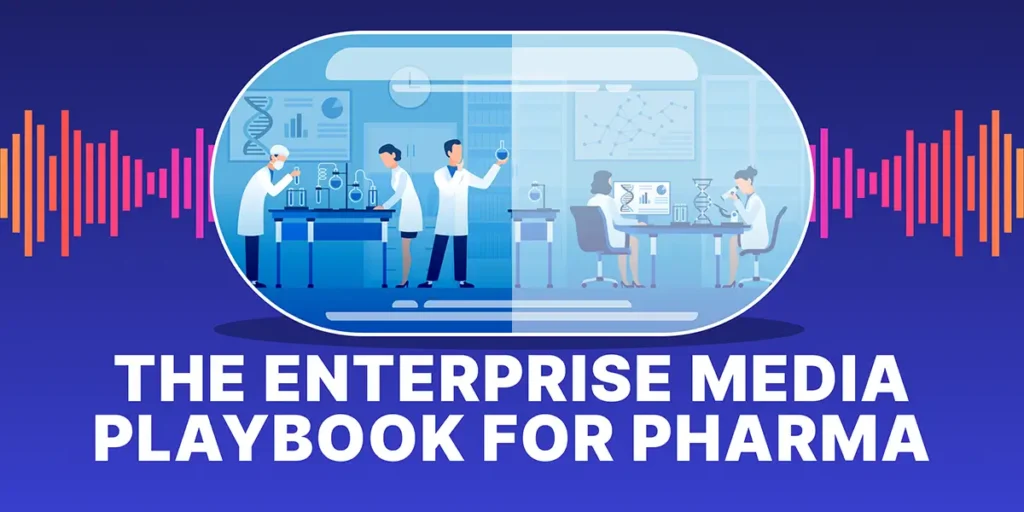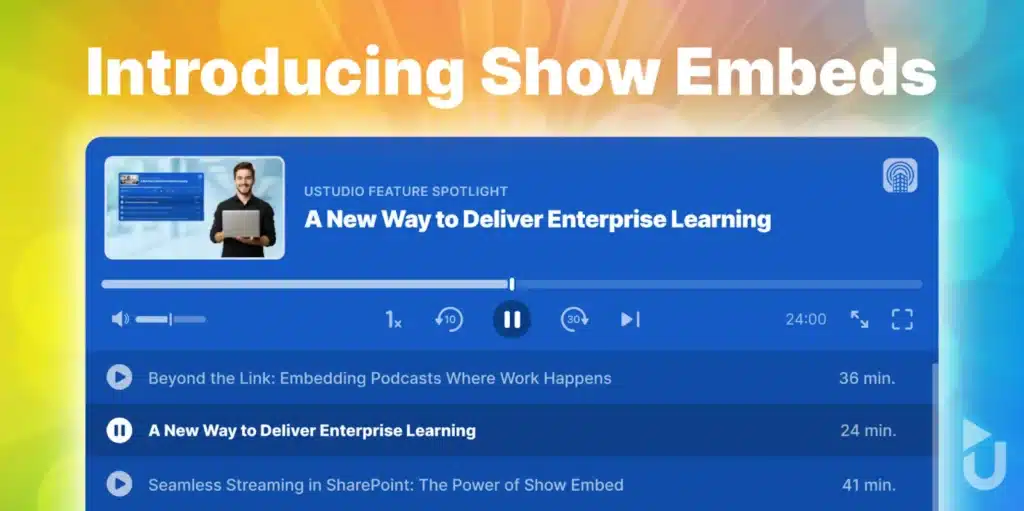Why Your Brain Loves Listening — Part 2: The Research Behind the Science
Michael Wright - VP of Sales at uStudio | Blog, Industry Trends, Podcasting

uStudio’s 3-Part Series: Why Your Brain Loves Listening
Podcasts have surged in popularity as a learning medium, raising questions about why so many people gravitate to audio for education. Cognitive science offers insights into this preference by examining how podcasts engage our attention, memory, and thought processes. Research suggests that learning via podcasts can be just as or more effective than traditional reading or watching videos, while offering unique benefits in terms of multitasking and engagement. We explore key cognitive factors — attention, memory retention, engagement, and cognitive load – and compare podcasts with reading and video, supported by studies and expert insights.
Part 2: The Research Behind the Science
1. Listening to Audio Enhances Concentration and Attention
Audio podcasts occupy a unique niche by engaging the mind without needing visual attention. One of the reasons enterprise learners prefer audio podcasts is the ability to consume content while doing other activities (scanning emails, commuting, chores, exercising). Unlike reading or even watching video, which demand visual focus, listening to content frees the eyes and can accompany routine tasks. Surprisingly, multitasking doesn’t necessarily mean shallow attention.
Physical movement while listening can boost engagement.
A recent study of medical trainees found that listeners’ EEG-measured attention levels were no different whether they sat still or walked on a treadmill while listening to an educational podcast. In fact, participants’ brain attentional networks were just as engaged during podcast listening as during focused reading. A BBC Global News neuroscience study found that when people listened to podcasts while active (e.g. doing chores), their engagement was 18% higher and their emotional intensity 40% higher, compared to when they listened in a passive state . This physical activity also led to a 22% increase in long-term memory encoding of the content. The theory is that a mildly active body can keep the brain alert (a concept known as low-involvement processing), so listeners remain attentive to the podcast. In essence, podcasts let people pay attention and learn during activities where other formats like reading and video can’t be used, capitalizing on our brain’s ability to divide attention between a routine task and an audio narrative.
Following audio narratives enhances concentration
Podcasts do however require continuous attention to follow the narrative or argument, since audio is transient (you can’t easily skim or pause in the middle of a sentence as when reading text). In a relevant study from March 2024, researchers found that listening to spoken information demands “enhanced concentration.” A listener must actively follow along, which can actually be a boost to attention, helping the mind prevent mind-wandering and distraction. Another experiment showed that playing recorded speech to drivers prevented attention drift compared to silence, helping them stay mentally engaged while driving. With audio podcasts, learners can maximize their attention by turning previously “dead time” (like commuting) into learning time, without significant loss of focus or comprehension.
2. Podcasts Can Boost Memory Retention and Learning Effectiveness
An essential question is whether people remember what they learn from podcasts as well as from reading or videos. Research generally shows that well-designed audio content can achieve comparable or better memory retention to other formats. The aforementioned randomized trial with medical students compared learning from a podcast vs. reading a textbook chapter on the same topics. Immediately after learning, the podcast groups scored significantly higher on knowledge tests than the reading group; even after four weeks, their retention was equivalent or better for most topics. The figures in the study illustrate how podcast learners outperformed text learners on both immediate and long-term recall in that study.
Audio podcasts prompt your brain to paint pictures and memory traces.
Audio podcasts may also aid memory by leveraging how our brains encode information. Audio learning often involves storytelling or conversational explanations that can create vivid mental images and emotions. Neuroscience tells us that memory is strengthened when we actively think about and visualize content, not just passively receive it. With podcasts, listeners must paint a mental picture of what they hear – engaging in a form of imagination that can reinforce memory. Experts note that audiobooks and podcasts can evoke vivid mental imagery, which aids recall. Unlike video, which provides all the visuals for you, audio prompts your brain to generate its own, leading to deeper cognitive processing of the material. This aligns with the principle that “memory is the residue of thought” – we remember what we mentally grapple with. A compelling podcast forces you to follow along and think about the content, thereby laying down stronger memory traces.
Emotion enhances memory encoding.
It’s worth noting that emotion and interest also boost memory retention. A monotone lecture might be forgettable, but many podcasts use engaging narration, dramatic storytelling, or interviews with enthusiasm in the speaker’s voice. These elements can trigger emotional responses or personal connections that make the material stick. Studies in cognitive psychology show that emotion enhances memory encoding by activating the amygdala and other brain regions tied to memory. Thus, an inspiring or entertaining podcast is not just enjoyable – it’s also neurologically priming the brain to retain key points. As discussed earlier, physically active listeners may have elevated mood and thus better long-term recall of the content. So not only do people often prefer audio podcasts for convenience and multitasking, but also because they find they actually remember the material, especially if the audio format keeps them intrigued and thinking about the content.
3. Audio podcasts can create an emotional connection.
A standout feature of podcasts is the high level of personal connection they foster. Beyond just cognitive engagement, attention and memory improvement, podcasts can create a sense of intimacy and connection that is hard to replicate in text. Most podcast listeners tune in via headphones or in solitary settings. The result is an almost one-on-one atmosphere where the audio “voice” feels like it’s speaking personally to you. Studies of media psychology describe podcasts as an “intimate medium,” and listeners often develop parasocial relationships with their favorite hosts – a one-sided feeling of friendship or familiarity. Hosts who share spontaneous thoughts, personal anecdotes, or even their imperfect humanness come across as authentic, which strengthens this bond. From a cognitive standpoint, this intimacy and trust can increase motivation to pay attention and internalize what the host is teaching. Essentially, if a podcast feels like learning from a friend, our brains may be more receptive and engaged than if we’re reading a dry textbook or watching a formal lecture.
Engagement is also reflected in behavior: podcast listeners tend to finish episodes and stick with series at high rates. Industry research shows that 80+% (podcast listeners listen to most or all of each episode (even those 30 minutes or longer). This completion rate far exceeds typical engagement with online videos or articles, where users often drop off after a few minutes. The implication is that podcasts, through engaging storytelling and conversational delivery, keep people hooked on learning content for longer durations. The longer and more deeply someone processes material, the better they learn it. This might explain why a well-crafted educational podcast can leave a lasting impression – the format naturally encourages sustained attention and reflection, key ingredients for robust learning.
4. Cognitive Load and Information Processing
“Cognitive load” refers to the amount of working memory resources needed to process information. Different media can impose different types of load on learners. Audio podcasts strike a balance of cognitive load: they demand active listening (which uses brain power but in service of learning) and they remove extraneous visual demands, allowing learners to engage in deep processing of the auditory information.
Since many podcasts rely solely on the auditory channel, learners process spoken words sequentially. One might think having no visuals would lighten the load, but the reality is nuanced. Understanding spoken language (especially educational material) requires decoding words, maintaining attention, and continuously updating your mental model of the information. In cognitive terms, podcasts can have a high intrinsic load if the topic is complex, because the listener must hold and integrate ideas into memory as they arrive in a stream.
In spite of higher load, the absence of visuals in podcasts can also mean lower extraneous load (i.e. fewer unnecessary stimuli). With a book or video, a learner might be distracted by images, text layout, or on-screen movements. A podcast strips the experience down to just the content of the speech. This focused modality can be efficient for the brain in certain contexts. As long as the listener can follow along, audio may reduce the parallel processing of both visual and auditory information at once. According to the Cognitive Theory of Multimedia Learning, people have separate channels for visual and auditory processing, and combining them wisely (like narrating a diagram) can enhance learning. But if one channel (visual) is overloaded, learning suffers. Podcasts avoid any split attention between reading text and listening – you devote your cognitive resources to one stream of information. Some instructional designers even use audio narration to offload some cognitive load from the visual channel in e-learning. In the case of podcasts, all the load is on the auditory channel, which our brains are well-trained to handle (we’ve been learning by listening since infancy).
Interestingly, because you can’t see anything in an audio lesson, your brain often compensates by generating mental representations. This ties into the earlier point that podcasts spur imagination. Generating internal images or examples as you listen can increase the germane cognitive load, which is the productive mental effort that directly contributes to learning. For example, if a podcast describes a scientific process, you might mentally visualize how it works. That uses cognitive resources, but in a beneficial way that strengthens understanding and memory. Indeed, research has observed that audio-based learning encourages learners to form mental models and imagery, which can deepen comprehension as we learned earlier. In contrast, video can sometimes present information so concretely that the learner doesn’t need to actively imagine anything, potentially leading to a more passive processing. In podcasts, you have to do a bit more mental work to construct knowledge, which, when the load is manageable, can lead to stronger learning outcomes.
In sum, audio podcast producers must ensure they are creating simple and well-structured content to take advantage of the balanced cognitive load benefits of podcasts for learning and engagement. Allowing users to maintain cognitive “efficiency” is key to realizing ROI on your corporate podcast programs.

Michael Wright is a seasoned sales and customer success leader with over 15 years of experience in sales, account management, and client success. He has held progressive leadership roles at companies such as SpareFoot (2011–2017) and Rollick (2017–2022), where he served as VP and Director of Sales and Account Management. Currently, he is the VP of Sales and Customer Success at uStudio and an Executive Member at Pavilion.
Michael began his career as a Surgical Attendant at St. Mary’s Hospital and later transitioned into sales and account management roles at IT Convergence, Precision Tune Auto Care, and others. He holds a B.A. from the University of Virginia and completed a Post Baccalaureate Pre-Medical Program at UC Berkeley Extension.



